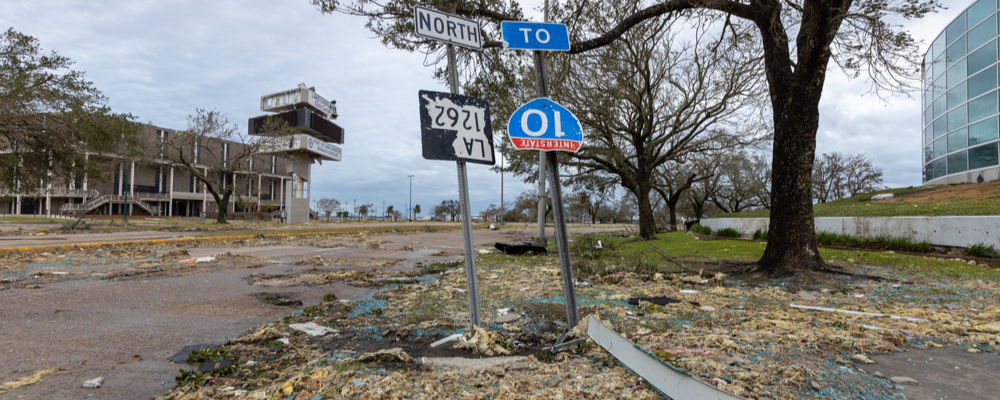 Hurricane Laura made landfall as a Category 4 storm in downtown Lake Charles, Louisiana. Image credit: Jeff Gammons/Shutterstock, 2020.
Hurricane Laura made landfall as a Category 4 storm in downtown Lake Charles, Louisiana. Image credit: Jeff Gammons/Shutterstock, 2020.
By Jennifer Collins and Amy Polen
Traditionally, evacuations and public sheltering protect those who are most at risk during a hurricane; however, such measures can be in direct conflict with the need to socially distance during the COVID-19 pandemic. Emergency management offices nationwide have revisited emergency procedures to limit the risk of disease transmission, but our research shows that the public is still wary of contracting COVID-19 during evacuation and sheltering.
Research on evacuation behavior during a global pandemic is vital to ensuring emergency management planning and risk communication is effective, especially since individuals who encounter unfamiliar risks might have to make unanticipated decisions. Individual risk perception is highly subjective and often includes personal assessments of health status, hurricane risk, and public shelter safety. Understanding individual risk perception during the COVID-19 pandemic can shed light on why people might choose to shelter in place rather than evacuate, even when such a choice poses danger.
Our multi-year research examines individual health and risk perceptions and how hurricane threats, compounded by the risks of the COVID-19 pandemic, influences potential and actual protective action decisions such as evacuation or sheltering at home.
A pilot study conducted in June 2020 looked at how individuals expected they would react to a hurricane threat during the COVID-19 pandemic. The study, which surveyed more than 7,000 people living in Florida, showed that nearly half of the respondents viewed themselves as vulnerable to COVID-19 because of pre-existing health conditions and that 74.3% of that sample considered the risk of staying in a shelter during the pandemic to be more hazardous than sheltering in place during a hurricane. A significant number of respondents who would have likely accessed a shelter previously indicated they would now not because of the additional COVID-19 risks—a 7.8% drop in anticipated shelter usage compared to respondent’s likelihood to shelter before the pandemic.
These results highlight what people thought they would do, but we also wanted to learn what people actually did. This led us to conduct a survey of people who experienced Hurricanes Laura and Sally, which made landfall in Louisiana in August 2020 and Alabama during September 2020, respectively. The design of this survey was inspired by the pilot study, but looked at actual evacuation decisions and perceptions of risk immediately following the events. A combined convenience and snowball sampling method was used, supported by our professional network of emergency managers, researchers, and meteorologists who distributed the survey in local communities impacted by the hurricanes.
Our analysis showed that less than one percent of individuals surveyed accessed a public shelter. The overwhelming majority of individuals (76.7%) stayed in their homes during Hurricanes Laura and Sally. Respondents expressed many of the same reasons for staying home as those cited in the pilot survey, including a high rate of perceived health vulnerability (34.9%) and generally negative perceptions of shelters.
Interestingly, perceptions of shelters among those who had experienced Hurricanes Laura and Sally was more favorable than those in the pilot survey, although the majority (58%) still indicated that they felt the risk of staying in a shelter during the pandemic was more dangerous than risks posed by the hurricane.
Even so, 87% of respondents noted that their pre-hurricane perceptions of shelter safety still felt accurate to them after they experienced a hurricane. These results indicate that concern about hurricane impacts matter more in an actual event than when compared to hypothetical planning. As one respondent said, “I guess everyone is in survival mode. We are more concerned with food and shelter than the virus. To be honest, the virus seems very far away right now to people who have lost quite literally everything they have.”
These results highlight differences in the decisions people think they would make compared to those they actually make to protect themselves in light of the COVID-19 pandemic. Public shelters are traditionally used by vulnerable populations, such as the elderly and those with lower socioeconomic opportunities. If such individuals are hesitant to use shelters during the pandemic, emergency managers and shelter organizers might have to take extra steps to ensure individuals are confident about sheltering and evacuation options so that they don’t put themselves at undue risk by sheltering in their homes.
In such situations, communication campaigns should emphasize that necessary precautions have been taken to help protect evacuees and shelter residents from COVID-19 infection. This could build trust and potentially encourage people to move out of harm’s way in future disasters that occur during the pandemic. Other measures can also be taken to persuade evacuation, as well. For instance, during Hurricane Laura, government officials made arrangements for people to shelter in hotels rather than in congregate shelters.
Disaster planners and communicators can use the results presented here to better understand how pandemic measures, such as social distancing, can impact emergency planning for evacuations and sheltering. Disasters are growing in frequency and severity and taking these considerations into account can help anticipate future challenges that will likely arise in the reality of an ongoing pandemic.
Jennifer Collins is a professor in the School of Geosciences at the University of South Florida. Her research focuses on weather and climate. As a hurricane researcher, Collins is interested in the interaction between large scale climatic patterns and seasonal patterns of tropical cyclone activity in multiple oceanic basins. As well as her work in the physical sciences she also works in the social sciences as she examines human behavior relating to hurricane evacuation. In addition to her hurricane work, Collins works in other areas related to weather, climate and hazards.